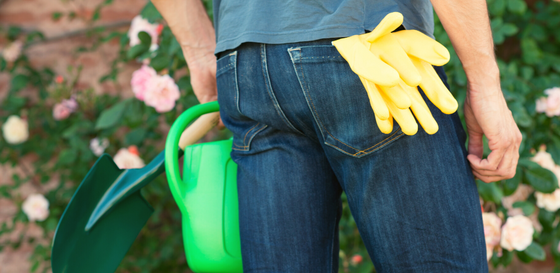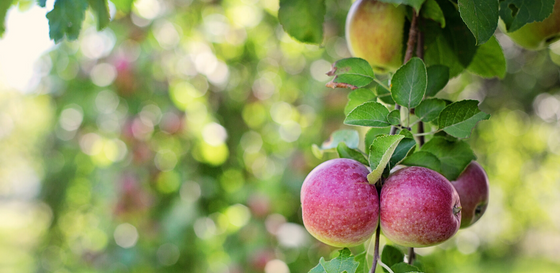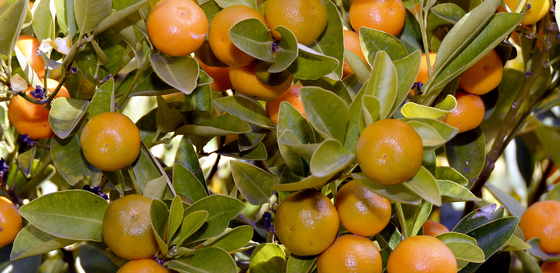
Before you apply any spray to your Fruit Salad Tree, there are a few things you can do; give your garden a clean up by removing any old mulch and leaves, do a pH test (stone should be 6.0-7.0, citrus like 5.5-6.5 and apples prefer 5.8-7.0), add some slow release fertiliser and apply new mulch to the top, ensuring it is at least 15cm from the trunk.
Apple and stone fruit trees are deciduous, which means they lose their leaves in Winter to store energy for their new growth in Spring. When the leaves have all dropped, give the tree a balance (cutting each graft to an even length including the thickness) and remove any weak/damaged branches, any branches that are rubbing against/crossing each other and any dead wood. Make sure your secateurs are clean and sharp. If the leaves have not all fallen from the tree by mid June, you can remove these by hand.
For potted trees, now is a good time to check the tree is not root bound, fertilise and replenish the soil.
You can then spray your trees as detailed below:
To prevent fungal diseases and pests like Leaf Curl, Shot Hole, Freckle Rust, Blossom Blight (NSW, SA, TAS, VIC, QLD, ACT), San Jose Scale, Bryobia/ Clover Mite and Frosted Scale (QLD, TAS, VIC, SA, WA), we highly recommend applying one or both of the following applications:
At leaf fall ie Autumn (by early May – remove leaves if not fallen), spray thoroughly with Lime sulphur and surfactant, apply twice, about a week apart (Hand Sprayer is fine to use)
Be sure to spray Lime Sulphur on your Stone Fruit trees twice, waiting a week in between. Spray to the point of run off for thorough coverage. See the inside back cover of your Care Instructions for further details. Lime Sulphur is not a dangerous chemical (it is a bit smelly!) and you can purchase it anywhere where garden products are sold.
Tip: It's harder to get a good coverage of the spray onto the wood of the branches if leaves are still on the tree. So, apply the spray after the leaves have fallen. If leaves have not fallen off, see above in Deciduous Trees section and take them off yourself.
Note: Second Spray Application at Bud Swell (Winter onward, depending on your climate)
Use a Copper spray (Cuprous Oxide), adding a few drops of dishwashing liquid/ surfactant, at budswell (before the buds have burst) when the tree is beginning to wake up from dormancy. Can be as early as June in warmer regions! Do not forget to spray it twice!
If you miss spraying with the Lime Sulphur at leaf fall and you find that the buds on your tree begin to swell, getting a little bit "fluffy", it means it's getting ready to burst out with flowers (and fruits) and wake from dormancy. It is now time to spray with Copper. The timing of Spraying with Copper is critical because if flowers burst out on the tree before you spray with the copper, then it's too late for the protection spray to be effective. if you miss it, be sure to spray it the next year!
Tip: If you only wish to apply one of the sprays, we would recommend the Lime Sulphur application as the timing of the spraying is less critical.
Hot tip: If you have an Apricot on your Fruit Salad Tree then use the copper spray preventative option only as the lime sulphur mixture could upset them.
Consequences of Missing Spray Applications
If you have not sprayed the tree for prevention of Leaf Curl this season then the tree will be set back a little now and every year that the tree suffers from Leaf Curl, it will be weakened. There's nothing you can do about it once you see Leaf Curl. Just remove those ugly curly leaves and new growth will follow with normal leaves. Make sure you apply the two spray procedures next year. We'll also be reminding you!
Spray Stone Fruit and Apples for Aphids
Have a look for a tiny black/brown/green insects on the new leaves emerging after dormancy, these are not your friendly neighbourhood bugs, they are Aphids and can be active around July / August, attacking young new growth. We use a spray called Pyrethrum to eradicate them, usually, just one application will do the job, but check it in a few days and spray again if they are still moving. You can tell when they are dead because when you shake the leaf, they fall off. This spray is not harmful to the tree or the fruit and very user-friendly. You may not have this problem in your area and so may not have to spray.
Never mix the chemicals and wait approximately 6-8 weeks before applying anything else on your fruit tree.
Note: Do NOT apply Lime Sulphur to Red Delicious or Golden Delicious varieties.
Annual Winter pruning and sprays; when your citrus tree has finished fruiting, cut it back just a little and thin out branching to allow good air circulation and sunlight. Heavy pruning is not required.
Hot tip: Don’t feed your citrus tree Nitrogen rich products such as poultry or other manures until after it has finished flowering and the fruit is pea-sized. Too much nitrogen will stimulate new growth and make flowers and fruit drop. It also attracts pests like aphids, who will bring their mates the ants and the dreaded sooty mould. Try adding some Potash instead, a seaweed fertiliser and some Epsom Salts for sweet juicy fruit.
Citrus are ever-green so balancing and pruning your tree applies all throughout the year. After fruiting, cut back just a little and thin out branching for sunlight penetration. Heavy pruning is not required. Stone Fruits and Multi-Apples require balancing during their growing season.
Apart from the continual pruning for balancing and for shape, apply additional pruning during late May/early June. A guide for this is to prune 1/3 (young tree) to 1/2 (mature tree) of last season's growth. You can tell how much the tree grew last season by the different colours of the bark. Cut just above an outward pointing bud, not a bud on the inside of the branch because you don't need growth going in towards the middle of the tree. All growth needs to point away from the centre. Keep the middle fairly clear so sunlight can penetrate through the tree. Cut out any dead wood as well.
The ideal shape of a tree is a V shape coming out from the centre and upwards. All growth needs to be encouraged in a direction away from the centre of the tree. Sunlight needs to be filtering to all branches and fruits, so keep the centre of the tree reasonably open, some light branch work in the centre is ok. Prune out many inward growing branches and those growing in the wrong direction. This will not harm the tree but redirects energy to the outward growing branches.
Tip: Always cut above an outward pointing bud or leaf and thin out the laterals (side branches) to make a strong framework.

First fruits will appear in approximately 6-18 months. The reason being, when we graft a tree, we use pieces of wood from mature trees so there's not much waiting time for fruit to appear. However, because the tree is young, it hasn't had much time to develop and grow the framework that is needed to hold the fruit it's trying to produce. It's best to take off these first fruits when they are the size of a tiny pea and allow the framework (branches) of all the grafts to develop first. This is especially important whilst the tree is young, especially the first year because the branches need to become thick and strong to be able to hold the fruit. You don't want the tree getting "bogged down" producing fruits. Leave just a couple of pieces of each and choose those pieces closest to the thicker part of the branch, not at the very end of the branch where it's thinner. Keep growth of branches ahead of the fruit production.
As the tree grows, thin out the amount of fruit to set, always promoting branch growth as well. Again, the framework needs to be ahead of fruit production.
More fruit may be allowed to set on any faster-growing grafts, as that will slow down the growth of branches. However, always reduce fruits on any slower growing grafts as this allows more energy to go into the growth of the branches, don't slow it down further by allowing fruit production.
Be patient and keep each of the grafts growing at a similar rate, this is most important.
Once the tree has reached its full height and the branches are strong, you will no longer need to remove fruit. You'll probably have to watch that each graft is strong enough to hold all the fruit it produces. Often some thinning out of fruit is advisable so the weight of the fruit doesn't break branching. Every season allow the increase in fruit production.
We graft with ALL climate (low chill) and COLD climate (high chill) apple varieties. Both are susceptible to the same pests and diseases. However, the time for spray application will be slightly different due to their growth cycles varying. ALL climate apples tend to wake a little earlier.
All fruit trees need fairly regular feeding. Ideally, feed three to four times a year, late Winter for early Spring growth, then early Summer and early Autumn.
Make sure you vary your trees diet, slow release fertiliser is good (Osmocote with added trace elements), animal manure e.g. cow, sheep, horse, chicken (Chicken is a stronger manure so put it on top of the mulch rather than underneath) etc. Other excellent fertilisers are compost, trace elements, blood and bone, and Citrus all round fertiliser. From time to time you can add kitchen scraps under the mulch to attract earthworms.
Tip: When using fertilisers, keep it away from direct contact with the trunk of the tree. If you live in a frost prone area, then it is best not to fertilise in late Autumn because this can encourage new growth that can be burnt off with frost, wait for Spring.

Top up mulch on all Stone, Citrus and Apple trees when required. The best mulches are pea straw, sugar cane, or even a mixture of things like old grass clippings (not fresh as it heats up and can burn the roots of a tree, let it dry out before raking). Well rotted, disease free leaf mulch is also very good. The thicker the better, it breaks down further over time, so it will need topping up every 4-6 months at least. It's very good for keeping the moisture level constant underground. Pea and sugar cane mulches can break down to add valuable nitrogen to the soil.

Maintain adequate soil moisture in dry-winter years to help prevent water stress on the trees; stressed trees are more likely to be damaged by frost. Cover the trees, mainly citrus, with a ‘frost cloth’ or even a hessian bag when frost/extreme cold weather is predicted. If a protective frost cover is used at night, make sure that it is removed each morning to allow bee pollination.
Feed liquid seaweed at a rate of 10ml/9L of water, plus liquid potassium (20ml/9L) to strengthen cell walls and give the plants a few extra degrees worth of protection.
If your tree requires additional nutritional elements, add a mix of dolomite, lime and gypsum, which will increase nutrition and improve leaf appearance without stimulating a flush.
It is really important that you follow the two Special Care Requirements in order to keep your tree balanced. If you do not continually follow them, you will eventually end up losing grafts. One fruit's branch work (graft) will end up dominating and taking over the tree at the expense of the other grafts; this then obviously defeats the purpose of having a Fruit Salad tree. If you have not been following the two Care Requirements, the best thing to do is start now!
1. Maintain equal growth of your grafts
Establish a well 'balanced' tree by cutting back the more vigorous growing grafts anytime during the growing season, approximately once or twice a month. This is especially important while the tree is young and developing. Thin out the branching of each graft as needed, to equalise growth vigour otherwise the more vigorous growers will become bigger/stronger and dominate at the expense of the slower growers.
Do not just look at how long branches are and compare, also look at how many branches each graft has. If one graft has 6 branches and the others less, then cut back some of the branching of the bigger one because more energy is being stored in the bigger graft. The thickness of the branch coming from the main central stem of the tree is an indicator of how much energy it's consuming.
Hint: Keep each graft confined to grow in its own area of the tree; this will assist in recognising the faster and slower growers.
2. Remove rootstock growth
All new shoots emerging from the main central stem of the tree or from ground level must be removed. This is the growth of the rootstock tree. The only purpose of the rootstock is to nourish the grafts attached to it.
Hint: Identify the different grafts growing from the main central stem e.g. put a dub of paint on them (this has been done for you when you first get the tree from us). These are the anchor points of each graft. Check and remove all other growth from the main central stem (rootstock).
Note: Citrus rootstock has long thorns and a small 3 pronged leaf so is easier to identify.
Remember with younger trees to thin the first fruit that will appear. Dane shows how to prune and balance your young tree here.
You may like to train your grafts to grow in a certain fashion. Read more about training your tree with stakes here.
Did you know that you can also espalier any Fruit Salad Tree? Espalier your fruit tree by attaching the branches to wires or along a lattice framework, creating a fan shape which results in faster growth. Read more about espaliering your Fruit Salad Tree here.
We love seeing your Fruit Salad Tree grow. Feel free to share your growing pics with us by using #myfruitsaladtree on facebook on instagram if you have a public profile. Otherwise direct message us your photos. You can also ask us more detailed questions and our nursery staff can give you advice. Follow us on facebook and instagram today for more tips, tricks and specials.
Our fast fruiting trees can be grown in the ground, or in pots on your balcony. For more information on growing your tree in a pot, read our detailed guide here. For information on planting your Fruit Salad Tree read our step by step guide here, and for planting your tree in clay soil, watch Sue's informative video in our article on planting in clay soil here.
Want more information? Sign up to our enewsletter for more growing tips, current specials and more from the Fruit Salad Tree family.
Fruit Salad Trees make perfectly different gifts! Our gift cards are emailed instantly. You can also shop our wide range of trees now and check out our current specials here!
Comments will be approved before showing up.

A handy list of essential items to make your gardening journey easier! From simple things like gardening gloves right through to fruit tree netting and a pH soil test kit, these will really help set you up for success in your patch. Whether you plan to grow veggies, fruit trees or flowers, this list will give you the confidence to get out in the garden and make the most of it all!

Here are some tips to help you keep your Fruit Salad Tree at it's best throughout the year. We all get busy and sometimes the garden jobs get forgotten. We get it!
We've popped these tips and tricks into categories (eg Citrus or Apple or Stonefruit) and then into seasons (eg in autumn remember to do this or keep an eye out for this in summer, etc.) to make things as easy as possible.
Happy, healthy fruit trees grow more fruit and that will make everyone happy!

There are many ways that you can become more sustainable and growing your own beautiful fruit tree at home is a great way to start!
In this short video, Kerry shows her veggie garden and the different types of Fruit Salad Trees to compliment edible gardens big and small.